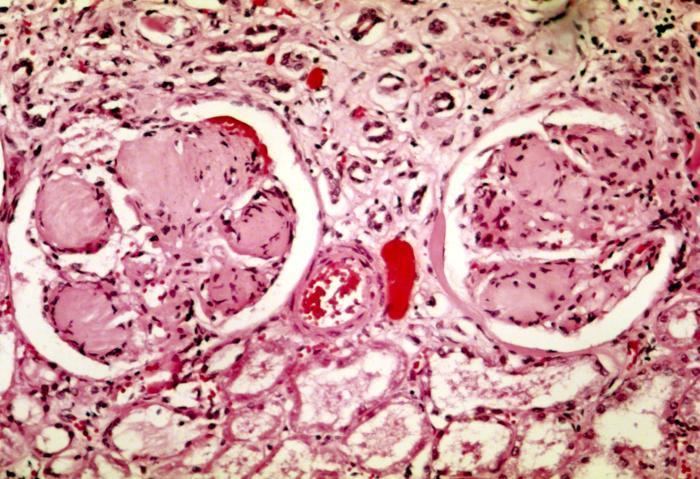Specialty endocrinology MedlinePlus 000494 | ICD-9-CM 250.4 MeSH D003928 | |
 | ||
ICD-10 E10.2, E11.2, E12.2, E13.2, E14.2 | ||
Diabetic nephropathy (or diabetic kidney disease) is a progressive kidney disease caused by damage to the capillaries in the kidneys' glomeruli. It is characterized by nephrotic syndrome and diffuse scarring of the glomeruli. It is due to longstanding diabetes mellitus, and is a prime reason for dialysis in many developed countries. It is classified as a small blood vessel complication of diabetes.
Contents
Signs and symptoms
During its early course, diabetic nephropathy often has no symptoms. Symptoms can take 5 to 10 years to appear after the kidney damage begins. These late symptoms include severe tiredness, headaches, a general feeling of illness, nausea, vomiting, frequent voiding, lack of appetite, itchy skin, and leg swelling.
Causes
The cause of diabetic nephropathy is not well understood, but it is thought that high blood sugar, advanced glycation end product formation, and cytokines may be involved in the development of diabetic nephropathy.
Kidney damage is likely if one or more of the following is present:
Mechanism
Diabetes causes a number of changes to the body's metabolism and blood circulation, which likely combine to produce excess reactive oxygen species (chemically reactive molecules containing oxygen). These changes damage the kidney's glomeruli (networks of tiny blood vessels), which leads to the hallmark feature of albumin in the urine (called albuminuria). As diabetic nephropathy progresses, a structure in the glomeruli known as the glomerular filtration barrier (GFB) is increasingly damaged. This barrier is composed of three layers including the fenestrated endothelium, the glomerular basement membrane, and the epithelial podocytes. The GFB is responsible for the highly selective filtration of blood entering the kidney's glomeruli and normally only allows the passage of water, small molecules, and very small proteins (albumin does not pass through the intact GFB). Damage to the glomerular basement membrane allows proteins in the blood to leak through, leading to accumulation in Bowman's space as distinct periodic-acid schiff positive nodules called Kimmelstiel–Wilson nodules.
Diagnosis
Diagnosis is usually based on the measurement of high levels of albumin in the urine or evidence of reduced kidney function. Albumin measurements are defined as follows:
People with diabetes are recommended to have their albumin levels checked annually, beginning immediately after diagnosis for type 2 diabetics, and five years after diagnosis for type 1 diabetics. To test kidney function, the person's estimated glomerular filtration rate (eGFR) is measured from a blood sample. Normal eGFR ranges from 90 to 120 ml/min/1.73 m2.
Treatment
The goals of treatment are to slow the progression of kidney damage and control related complications. The main treatment, once proteinuria is established, is ACE inhibitor medications, which usually reduce proteinuria levels and slow the progression of diabetic nephropathy. Other issues that are important in the management of this condition include control of high blood pressure and blood sugar levels (see diabetes management), as well as the reduction of dietary salt intake.
Prognosis
Diabetic nephropathy in type 2 diabetes can be more difficult to predict because the onset of diabetes is not usually well established. Without intervention, 20-40 percent of patients with type 2 diabetes/microalbuminuria, will evolve to macroalbuminuria.
Diabetic nephropathy is the most common cause of end-stage kidney disease, which may require hemodialysis or even kidney transplantation. It is associated with an increased risk of death in general, particularly from cardiovascular disease.
Epidemiology
In the U.S., diabetic nephropathy affected an estimated 6.9 million people during 2005–2008. The number of people with diabetes and consequently diabetic nephropathy is expected to rise substantially by the year 2050.
